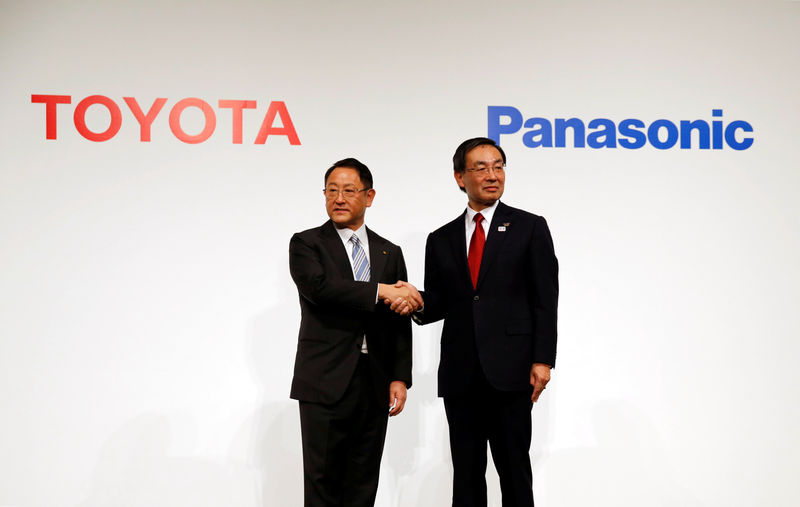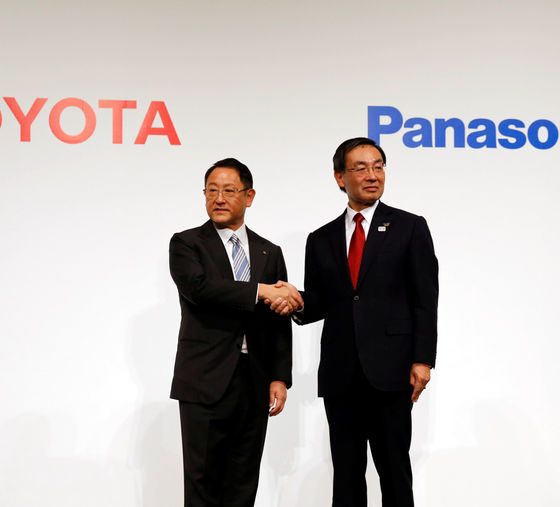

News
Panasonic looks beyond Tesla, signs Toyota partnership on electric car battery venture in 2020
Toyota Motor Corporation and Panasonic are combining resources in a joint venture to produce electric vehicle batteries that will begin in 2020, according to a report published by Nikkei Asian Review. To compete with Chinese players rapidly growing into the EV arena, five Panasonic battery manufacturing facilities in Japan and China will be made part of the new partnership to boost their production to reach 50 times the current capacity. The pooling of resources could provide both companies with much-needed network resources to increase their EV market presence.
The two Japanese manufacturing giants already have experience in collaboration with one another – Primearth EV Energy is their venture producing batteries for Toyota and Honda hybrid vehicles. This new collaboration will first aim to ramp up production and triple Toyota’s annual EV sales to 5.5 million by 2030, but it will also work to develop next-generation high-capacity solid-state lithium batteries, a goal needing plenty of capital and access to top talent. The company’s electric vehicle partner Mazda Motor and subsidiaries Daihatsu Motor and Subaru may be initial recipients of the newly produced batteries, with Panasonic-supplied Honda Motor on the wish list for product adoption.
A partnership deal between Panasonic and Toyota was first reached in 2017. An official announcement may take place later this week according to Nikkei’s source.

As of 2017, about 60% of world’s lithium-ion batteries are made in China, and the government there is taking aggressive steps to expand on that number. Tesla’s red carpet treatment with its Gigafactory 3 is a testament to this, with limited land bids in their favor and even “green card” residency being offered to CEO Elon Musk. Toyota has not kept up with its Chinese and Volkswagen EV rivals in the market, thus a partnership enabling a widened resource network and customer reach opportunities seems to be part of a competitive strategy. The carmaker will reportedly own 51 percent in the new venture with Panasonic.
In addition to a quickly expanding presence in China, adding to Toyota’s EV woes in the country, Tesla has its own partnership history with both of the venturing companies in the battery and electric vehicle manufacturing arena. In 2010, Toyota purchased $50 million of Tesla stock as part of a vehicle-cooperation agreement which also included the development of a version of the Japanese automaker’s RAV4 model with a Tesla electric powertrain. Company culture clashes first sunk that part of the deal in 2014, and the full relationship drifted apart and ended in 2017 as a result of Tesla’s eventual emergence as a full-fledged Toyota competitor in the green car market, while the Japanese automaker focused on hydrogen cars.
Panasonic, on the other hand, continues to have a battery production agreement with Tesla, and may even be intending to double down on that partnership by bringing operations to a US-based location this year. Some US production – Model 3 2170 cells – is already done inside Gigafactory 1 by Panasonic, but the Model S and Model X cells are still made in the company’s Japanese factories. According to the Nikkei report, the new joint venture between the Japanese manufacturers will not include any of Panasonic’s Tesla cell producing factories.

News
Tesla FSD fleet is nearing 7 billion total miles, including 2.5 billion city miles
As can be seen on Tesla’s official FSD webpage, vehicles equipped with the system have now navigated over 6.99 billion miles.

Tesla’s Full Self-Driving (Supervised) fleet is closing in on almost 7 billion total miles driven, as per data posted by the company on its official FSD webpage.
These figures hint at the massive scale of data fueling Tesla’s rapid FSD improvements, which have been quite notable as of late.
FSD mileage milestones
As can be seen on Tesla’s official FSD webpage, vehicles equipped with the system have now navigated over 6.99 billion miles. Tesla owner and avid FSD tester Whole Mars Catalog also shared a screenshot indicating that from the nearly 7 billion miles traveled by the FSD fleet, more than 2.5 billion miles were driven inside cities.
City miles are particularly valuable for complex urban scenarios like unprotected turns, pedestrian interactions, and traffic lights. This is also the difference-maker for FSD, as only complex solutions, such as Waymo’s self-driving taxis, operate similarly on inner-city streets. And even then, incidents such as the San Francisco blackouts have proven challenging for sensor-rich vehicles like Waymos.
Tesla’s data edge
Tesla has a number of advantages in the autonomous vehicle sector, one of which is the size of its fleet and the number of vehicles training FSD on real-world roads. Tesla’s nearly 7 billion FSD miles then allow the company to roll out updates that make its vehicles behave like they are being driven by experienced drivers, even if they are operating on their own.
So notable are Tesla’s improvements to FSD that NVIDIA Director of Robotics Jim Fan, after experiencing FSD v14, noted that the system is the first AI that passes what he described as a “Physical Turing Test.”
“Despite knowing exactly how robot learning works, I still find it magical watching the steering wheel turn by itself. First it feels surreal, next it becomes routine. Then, like the smartphone, taking it away actively hurts. This is how humanity gets rewired and glued to god-like technologies,” Fan wrote in a post on X.
News
Tesla starts showing how FSD will change lives in Europe
Local officials tested the system on narrow country roads and were impressed by FSD’s smooth, human-like driving, with some calling the service a game-changer for everyday life in areas that are far from urban centers.

Tesla has launched Europe’s first public shuttle service using Full Self-Driving (Supervised) in the rural Eifelkreis Bitburg-Prüm region of Germany, demonstrating how the technology can restore independence and mobility for people who struggle with limited transport options.
Local officials tested the system on narrow country roads and were impressed by FSD’s smooth, human-like driving, with some calling the service a game-changer for everyday life in areas that are far from urban centers.
Officials see real impact on rural residents
Arzfeld Mayor Johannes Kuhl and District Administrator Andreas Kruppert personally tested the Tesla shuttle service. This allowed them to see just how well FSD navigated winding lanes and rural roads confidently. Kruppert said, “Autonomous driving sounds like science fiction to many, but we simply see here that it works totally well in rural regions too.” Kuhl, for his part, also noted that FSD “feels like a very experienced driver.”
The pilot complements the area’s “Citizen Bus” program, which provides on-demand rides for elderly residents who can no longer drive themselves. Tesla Europe shared a video of a demonstration of the service, highlighting how FSD gives people their freedom back, even in places where public transport is not as prevalent.
What the Ministry for Economic Affairs and Transport says
Rhineland-Palatinate’s Minister Daniela Schmitt supported the project, praising the collaboration that made this “first of its kind in Europe” possible. As per the ministry, the rural rollout for the service shows FSD’s potential beyond major cities, and it delivers tangible benefits like grocery runs, doctor visits, and social connections for isolated residents.
“Reliable and flexible mobility is especially vital in rural areas. With the launch of a shuttle service using self-driving vehicles (FSD supervised) by Tesla in the Eifelkreis Bitburg-Prüm, an innovative pilot project is now getting underway that complements local community bus services. It is the first project of its kind in Europe.
“The result is a real gain for rural mobility: greater accessibility, more flexibility and tangible benefits for everyday life. A strong signal for innovation, cooperation and future-oriented mobility beyond urban centers,” the ministry wrote in a LinkedIn post.
News
Tesla China quietly posts Robotaxi-related job listing
Tesla China is currently seeking a Low Voltage Electrical Engineer to work on circuit board design for the company’s autonomous vehicles.

Tesla has posted a new job listing in Shanghai explicitly tied to its Robotaxi program, fueling speculation that the company is preparing to launch its dedicated autonomous ride-hailing service in China.
As noted in the listing, Tesla China is currently seeking a Low Voltage Electrical Engineer to work on circuit board design for the company’s autonomous vehicles.
Robotaxi-specific role
The listing, which was shared on social media platform X by industry watcher @tslaming, suggested that Tesla China is looking to fill the role urgently. The job listing itself specifically mentions that the person hired for the role will be working on the Low Voltage Hardware team, which would design the circuit boards that would serve as the nervous system of the Robotaxi.
Key tasks for the role, as indicated in the job listing, include collaboration with PCB layout, firmware, mechanical, program management, and validation teams, among other responsibilities. The role is based in Shanghai.
China Robotaxi launch
China represents a massive potential market for robotaxis, with its dense urban centers and supportive policies in select cities. Tesla has limited permission to roll out FSD in the country, though despite this, its vehicles have been hailed as among the best in the market when it comes to autonomous features. So far, at least, it appears that China supports Tesla’s FSD and Robotaxi rollout.
This was hinted at in November, when Tesla brought the Cybercab to the 8th China International Import Expo (CIIE) in Shanghai, marking the first time that the autonomous two-seater was brought to the Asia-Pacific region. The vehicle, despite not having a release date in China, received a significant amount of interest among the event’s attendees.








